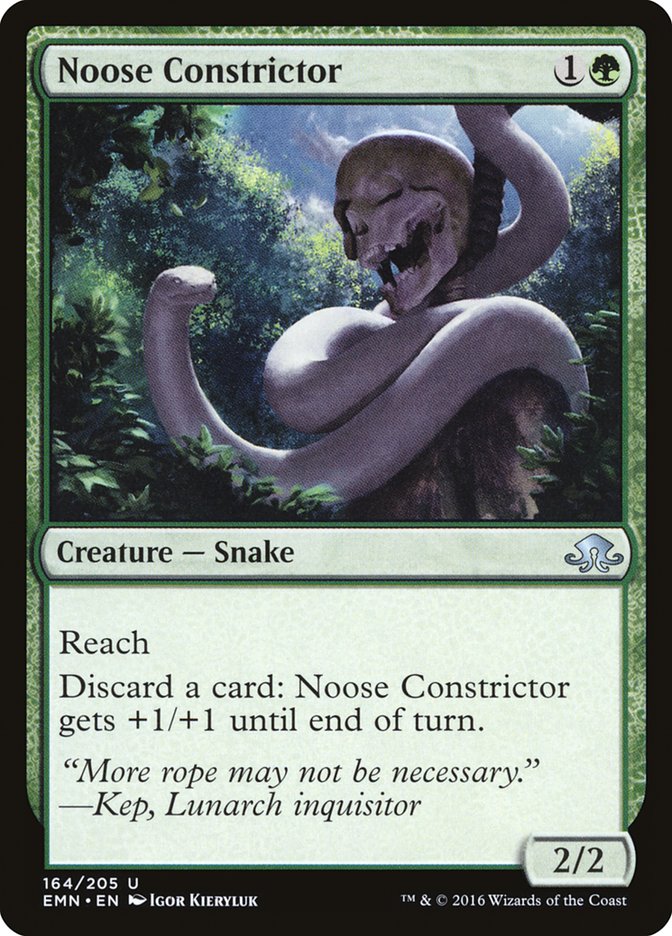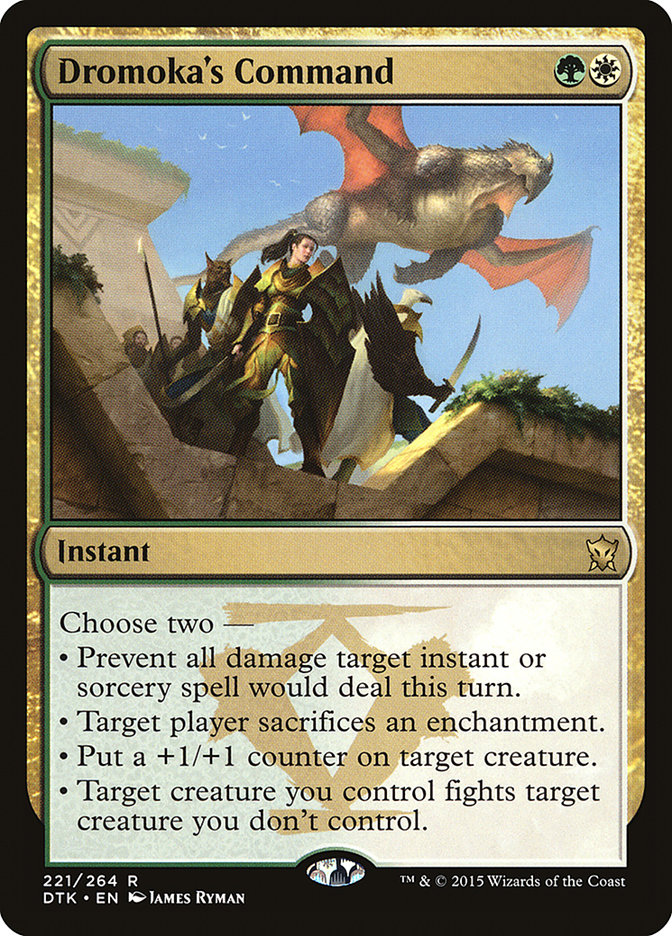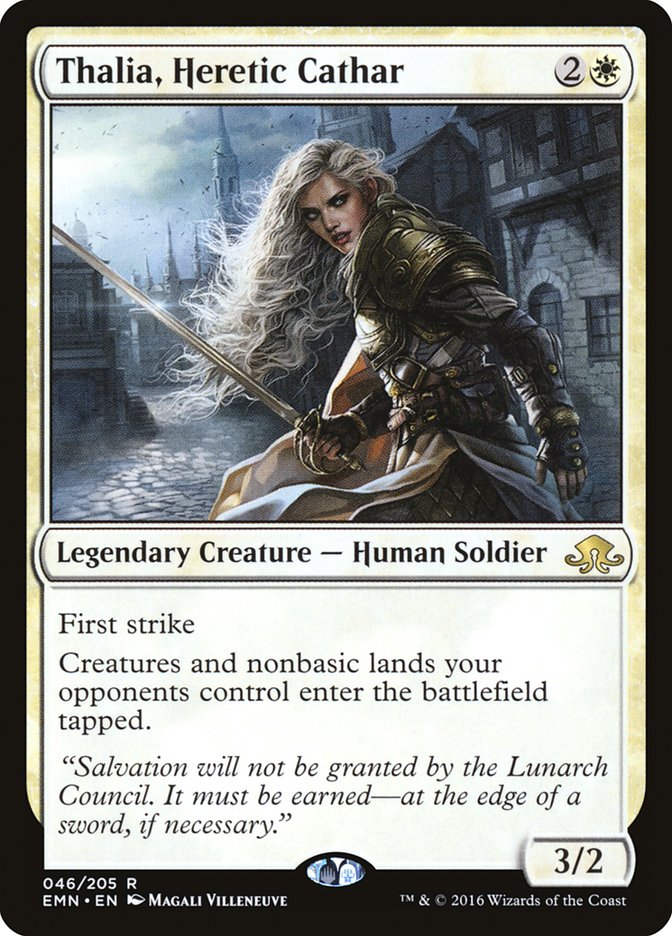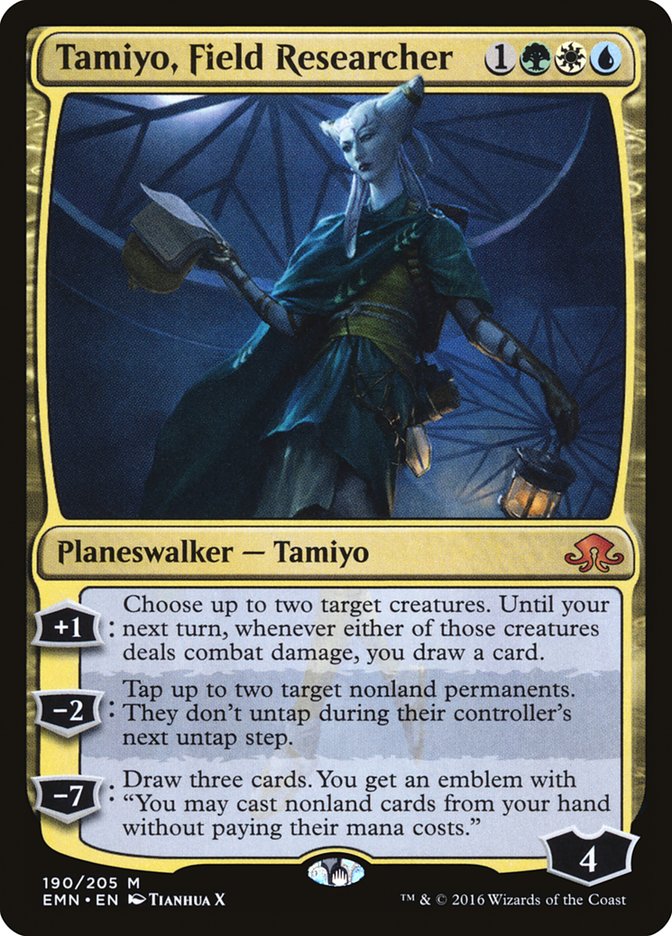Pro Tour Eldritch Moon was an interesting event from a deckbuilding standpoint. Going into it, everyone knew Bant Company was great and would be the deck to beat. It wasn’t readily apparent that there were decks, or even a deck, that would be capable of doing so.
That meant you would either be in the camp of beating or joining Bant Company.
I resisted as long as I could. I tried to build something stylish and powerful, but in the end I just couldn’t find a good enough reason to not play Bant.
Bant Company is filled with cards packed with raw power and built-in card advantage, has plenty of play to it, and easily makes things miserable for your opponent. It comes with free wins attached to your best starts and is great at putting the opponent to the test, asking them, “Is your draw good enough to beat this?”
So I caved and locked in on Bant Company, setting out to build the best version I could.
I was actually surprised only 20% of the field played it. I think there was some fear picking up a deck with such a massive target on its back, and Eldritch Moon did have a lot of powerful new cards.
But sometimes the best decision is to just pick up the best deck.
I went 7-2 with Bant (not including conceding my last round) and 3-3 in Draft. I had a good run with the deck and it consistently felt amazing. I was in Top 8 contention until the second-to-last round, so it was a little disappointing not sealing the deal, but I was happy with my play and it felt like things just didn’t quite break my way.
While the story of the Pro Tour was that Bant Company can be matched by other decks, rest assured it’s still a force to be reckoned with.
Here’s what I ran:
Creatures (26)
- 4 Reflector Mage
- 4 Sylvan Advocate
- 3 Tireless Tracker
- 4 Duskwatch Recruiter
- 3 Thalia, Heretic Cathar
- 4 Spell Queller
- 4 Noose Constrictor
Planeswalkers (1)
Lands (25)
Spells (8)

This is why we Bant have nice things.
Naturally I set out to tune my list to beat the mirror and the decks that would be trying to crush Bant Company.
I wasn’t sure what archetypes would show up in great numbers or exactly what the polished versions of those decks would end up looking like, but it seemed like the two main strategies best against Bant Company would be black control decks with Grasp of Darkness, Languish, and Liliana, the Last Hope as well as the emerge decks.
One thing important to keep in mind when you begin testing against good versions of the perceived best deck in the format to try and beat it is that, even though the deck may be more polished than your brews, it still may be improved upon as well.
That means it’s possible to brew up a deck that appears to beat a deck like Bant Company, only to learn that the deck you were trying to beat has evolved into something even more powerful. So make sure to keep updating the stock versions of the best deck while trying to beat it in testing.
If there are three or four different versions of the best archetype, it can be tricky accounting for all of them and predicting what people will bring to the tournament, which just adds to the complication of trying to have solid game against all of them.
If and when you do hit on an unexpected major improvement to the best deck, it’s a good indicator that you should just play that.
For my tinkering with Bant Company I wanted to keep my creature count high, and I managed to fit a delicious 26 creatures maindeck that are hits with Collected Company. The games where you cast Collected Company on turn 4 and hit two creatures are not remotely fair, and I wanted to improve the consistency in that regard. The curve on my version is somewhat low, which allows you to get away with 25 lands and cram in those extra creatures as well.
The most unique aspect of my list is definitely Noose Constrictor, which did not disappoint.
Just keep printing amazing green, blue, and white two- and three-drops, Wizards. Do you want to get Bants? Because that’s how you get Bants!
But back to Noose Constrictor specifically. Let me tell you:
The noose is loose.
The snake is awake.
The rope is dope.
The constrictor is ridic, sir.
Noose Constrictor is great at giving you an early battlefield presence and sticking around, and excellent at being aggressive or defensive. It can attack into pretty much anything in the early-game, and when it’s combined with the threat of Dromoka’s Command, it makes trying to block it with multiple creatures in the late-game miserable as well. You’re often more than willing to trade a card or two to get rid of a bigger threat and gain a tempo advantage.
Noose Constrictor is not only great at sneaking (or snaking) in two points every turn, but it also threatens to close out the game very quickly once your opponent’s life total dips low enough. I won plenty of games just pitching my entire hand of five or more cards to a Noose Constrictor. It makes combat awful for the opponent and makes them be constantly on guard if you get an early battlefield advantage or if they drop below ten life or so.
It also works well alongside Tireless Tracker, since each Clue sacrificed not only pumps Tireless Tracker but can also pump Noose Constrictor by giving you a card, which can make for many large attackers that require blocking.
Reach is also a nifty ability that makes Noose Constrictor great at threatening to block Spell Queller and Selfless Spirit during battlefield stalls.
Dromoka’s Command is largely ineffective against Noose Constrictor, since it’s very difficult to effectively fight the Snake or outgrow it in combat without it shedding its skin and getting too big to handle.
The Snake also has a little extra value, being easier to cast on turn 2 since it’s green, which is your main color.
One thing I didn’t put much stock into was Noose Constrictor versus Emrakul, the Promised End.
The bad news: if your opponent casts Emrakul, the Promised End and you have Noose Constrictor, you’re discarding your hand.
The good news is if your opponent casts Emrakul, the Promised End and you have Noose Constrictor on the battlefield, you have the option to discard your hand before your opponent can get their grubby paws on it and start casting those spells against you.
Ideally you’ll have emptied most of your hand before Emrakul becomes a major issue and it will just be a 13/13 wall.
All these little goodnesses add up to make Noose Constrictor un-boa-lievable.
Thalia, Heretic Cathar worked perfectly to complement the aggressive tone of the deck. Oftentimes your opponent is already on the back foot, and the extra annoyance of creatures and lands entering the battlefield tapped gives enough time to close the game out.
Tamiyo, Field Researcher was a fantastic one-of in the maindeck. It’s perfect for the aggressive gameplan or the longer grindy games. You rarely want to draw more than one Tamiyo, Field Researcher per game or to see one when resolving Collected Company, but having the option to cast it will often just win the game.
Her +1 is also great with Noose Constrictor, since you can attack into pretty much anything without worry and pitch some of those excess cards you’re drawing or just -2 and alpha strike, dumping a bunch of cards to the Snake.
Selfless Spirit is an amazing card but it does have drawbacks. The biggest one is of course Liliana, the Last Hope. Turn 3 Liliana, the Last Hope is going to be a difficult enough hurdle to overcome; getting a Selfless Spirit picked off is basically game right then and there. One toughness on a creature is a big red flag right now.
Selfless Spirit is kind of a victim of its own success and power level. Decks are already being built around the fact that indestructibility is a major player in Standard. Selfless Spirit doesn’t look so good against Grasp of Darkness, Languish, or Emrakul, the Promised End.
Even Kozilek’s Return is pretty good against Selfless Spirit. The Return is able to kill the Spirit for two damage when it’s cast, and you have to sacrifice Selfless Spirit before they even decide if they’re going to return the Kozilek’s Return from the graveyard to deal five damage to the battlefield.
I wanted to cut Archangel Avacyn for similar reasons, alongside it reducing the power of Collected Company and being an expensive card that would slow down the deck. It also gets less appealing the fewer Selfless Spirits you run.
At first I thought cutting Selfless Spirit and Archangel Avacyn would completely tank my chances of winning the mirror match, but as I slowly shaved more and more of the indestructible-ish fliers, it actually had the opposite effect.
Just focusing on consistency and pressure was enough. It’s not that difficult to play around Archangel Avacyn or get far enough ahead that she’s a nonissue. Even when your opponent has a solid battlefield presence and they have Selfless Spirit, you can avoid getting into big combat clashes by just attacking with one large creature at a time.
The same principle applied to Eldrazi Displacer. A powerful late-game card to be sure, but one that is clunky in the early-game, which is not what you want when so many games are decided by snowballing an early advantage.
Sideboard Guide
The Mirror
On the Play:
In:
Out:
On the Draw:
In:
Out:
The mirror is about grinding incremental advantages and pulling ahead on the battlefield with good trades wherever possible, poking your opponent for damage, and dealing with any problem creatures.
On the play, you want to snowball an advantage while watching out for blowouts from Tragic Arrogance or Archangel Avacyn. On the draw, ideally you also want to snowball an advantage, but you’re much less likely to do so, which means you’ll try to get an advantage with Tragic Arrogance.
Tragic Arrogance works really well with Noose Constrictor and Tireless Tracker. Sometimes you get rid of all your opponent’s creatures except one tapped one and then unleash a massive Kamehameha with Tireless Tracker or Noose Constrictor in your opponent’s face. Tireless Tracker also doesn’t care how your Clues get sacrificed, so you if you’ve been stockpiling clues and cast Tragic Arrogance, you can feed all of those Clues to one lucky Tireless Tracker.
B/W Control
In:
Out:
In building the sideboard, one of my main goals was to be able to interact with what the opponent’s end-game was. If I got out to an early battlefield lead, I wanted to be able to disrupt whatever the opponent was setting up to get them back in the game and stay ahead.
Ojutai’s Command, Negate, and Clash of Wills all worked well to this effect. Clash of Wills isn’t the most exciting card, but it’s excellent at dealing with whatever the opponent wants to throw at you in the late-game: Languish; Ishkanah, Grafwidow; Elder Deep-Fiend; Emrakul, the Promised End; Archangel Avacyn; or Tragic Arrogance.
I like to start shaving Collected Company once my creature count starts dipping to around 23 creatures as well, especially when Hallowed Moonlight is involved. I also like to aggressively play around Hallowed Moonlight, even if it means waiting on Collected Company or playing into Languish.
B/G Delirium
In:
Out:
Similar to B/W Control, except they’re more creature-heavy, so Reflector Mage is going to be more important here.
Emerge Decks
In:
Out:
Getting out to an early lead and keeping their battlefield clear of little emerge enablers is the recipe for success. If that doesn’t work, just being able to counter an Elder Deep-Fiend is fairly solid as well.
It’s a difficult balance to put on enough pressure while not getting blown out by Kozilek’s Return, and the best way to do that is keep their side of the battlefield empty.
Going Forward
It’s time for me to take my Snakes back on a plane and head home from the land down under, where Spirits Quell and Falls Lumber.
So what do I feel I did wrong this Pro Tour? Well, not too much.
This might be the first tournament where I wouldn’t change more than a few superficial misplays, Draft choices, and deck construction choices. I was happy with my deck and it felt like I won all the games I could and lost all the ones I couldn’t.
Which is actually a really strange feeling… usually there are some glaringly obvious blunders that caused my tournament to spiral into a mountainside and explode or a vastly superior deck choice I could have made.
As for my performance this season playing Magic, unfortunately I didn’t qualify for Worlds and I only made Gold this season, but that’s not too shabby and I’m certainly not unhappy. I’m optimistic and looking forward to another year of Magic!
What do you think about Bant Company going forward? Did the lists coming out of Pro Tour Eldritch Moon do enough to keep it in check, or is it still easily the best deck going forward?












